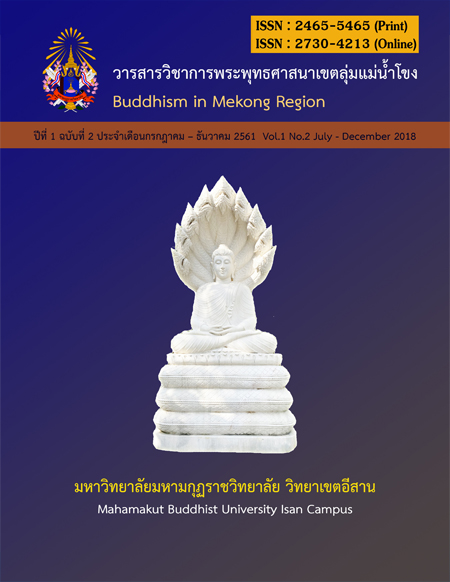The Vitality of the Knowledge of Sanskrit For Buddhism in Southeast Asia
Main Article Content
Abstract
Although Pāli was the main language of the southern Buddhist, the knowledge of Sanskrit is necessary to help more understanding Buddhism. As knowing for long time, the southern Buddhism, Theravāda, recorded the Buddha's teachings in Pāli, while the northern, Mahāyāna recorded in Sanskrit language. Studying Sanskrit has taken the important role in many countries which accepted the teachings of Theravāda Buddhism along with Pāli.
To understand the teachings of the Lord Buddha, we need to study the languages which has been recorded them in religious texts, not only Pāli but Sanskrit also. In our present time, difficulty of language makes trouble for people and they turned away. In Southeast Asia, many countries accepted the Buddha's teachings as the religion of mostly people. Therefore, to understanding and to practicing the Buddhism need ability of the languages. Moreover, the relation between Pāli and Sanskrit is very close in many aspects. So the knowledge of Sanskrit is very important to study Buddhism, both Theravāda and Mahāyāna. The Buddhist monks who have important role to spread and protect the right teachings in this global society more need to study and understand the religious languages.
Furthermore, there are many mistakes in interpretation of Buddhist virtues by the person who has not enough knowledge of Pāli and Sanskrit. In the current paper, the objectives are to study about the necessity of Sanskrit for Buddhism in Southeast Asia and Vietnam. to present the significant of knowledge of both Pāli and Sanskrit which being used to understand the Buddhism of the people in this region.
Article Details
- ผลงานที่ส่งตีพิมพ์จะต้องไม่เคยเผยแพร่ในสิ่งตีพิมพ์อื่นใดมาก่อนและต้องไม่อยู่ในระหว่างการพิจารณาของวารสารอื่น การละเมิดลิขสิทธิ์ถือเป็นความรับผิดชอบของผู้ส่งบทความโดยตรง
- ต้นฉบับที่ส่งตีพิมพ์ต้องเป็นภาษาไทยหรือภาษาอังกฤษเท่านั้น
- ต้นฉบับต้องผ่านการกลั่นกรองโดยผู้ทรงคุณวุฒิและได้รับความเห็นชอบจากกองบรรณาธิการ
- ในกรณีที่เป็นบทความแปล ต้องได้รับอนุญาตจากเจ้าของลิขสิทธิ์ โดยการขออนุญาตให้เป็นไปตามหลักจริยธรรมสากล
- ข้อความ เนื้อหา รูปภาพ และตาราง ที่ตีพิมพ์ในวารสาร เป็นความรับผิดชอบของผู้เขียนบทความแต่เพียงผู้เดียว มิใช่ความคิดเห็นและความรับผิดชอบของกองบรรณาธิการวารสาร กองจัดการ และมหาวิทยาลัยมหามกุฏราชวิทยาลัย วิทยาเขตอีสาน
6. ผลงานที่ได้รับการตีพิมพ์ถือเป็นลิขสิทธิ์ของวารสาร
References
Burrow, T. The Sanskrit Language. London: Faber and Faber, 1955, p. 61. Edgerton, F. Buddhist Hybrid Sanskrit Grammar and Dictionary Volume I: Grammar. Reprinted. Delhi: Motilal Banarsidass. 1985.
Geiger, Wilhelm. Pali Literature and Language. English Translation by Batakrishna Gohsh. Delh: Munshiram Manoharlal Publishers. 1996.
Horner, I. B. The Book of the Discipline. Oxford: The Pali Text Society, 1997 p 193-194
Davids, T.W. Rhys and Oldenberg, Hermann. Sacred Books of the East. Vol. 20 Vinaya Texts Part ii: the Kullavagga. iv-xii. Delhi: Motilal Banarsidass, 1885. p 150-151 Nikul Joshi "Sanskrit" [2017 July 4] Available from: http://www.ancient.eu/Sanskrit/
Wader, A. K. Introduction to Pali. 2nd ed. London: The Pali Text Society, 1974. http://www. dsbcproject.org/


